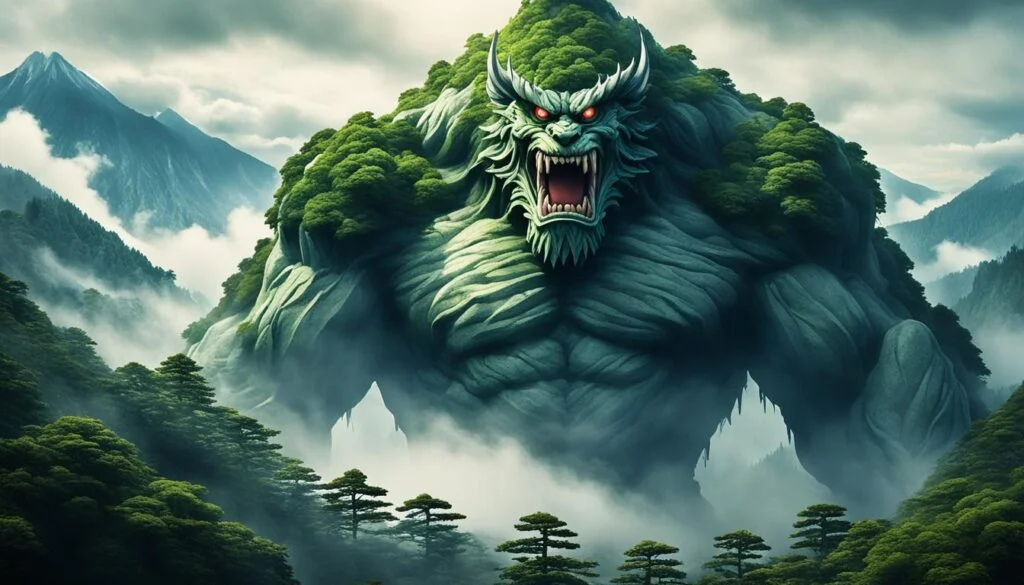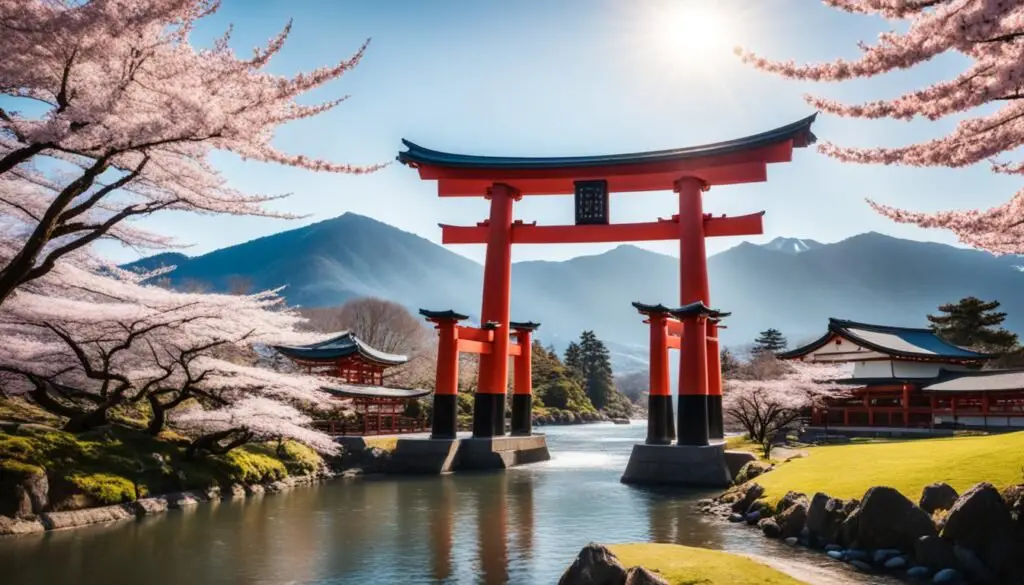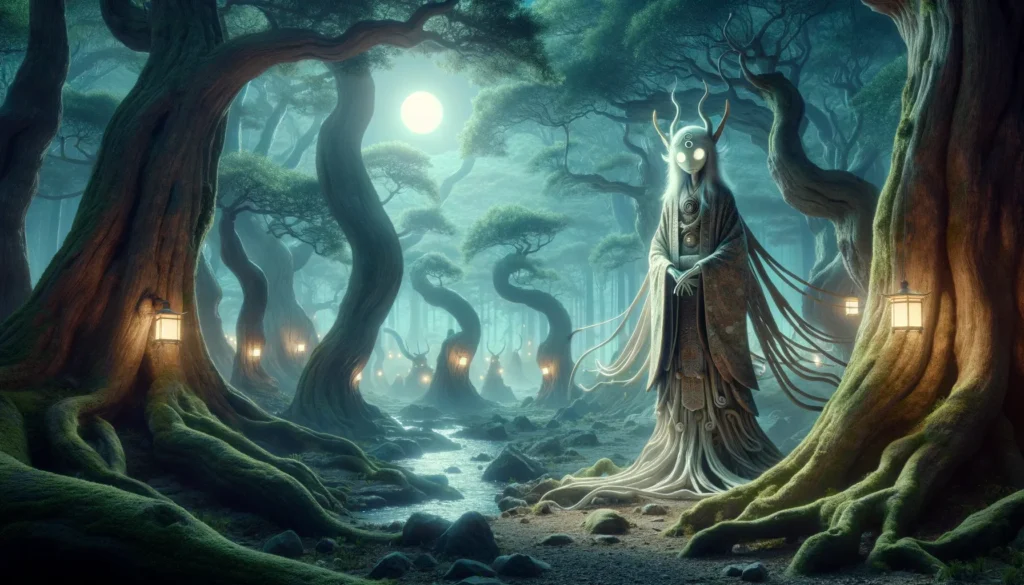Welcome to our exploration of the fascinating world of Japanese mythology! In this article, we will embark on a journey through the rich tapestry of Japanese myths and legends, focusing specifically on the awe-inspiring giants that inhabit this enchanting realm.
Yes, giants do appear in Japanese mythology, often depicted as powerful and sometimes malevolent beings. One of the most famous giants is the demon Oni, which can be considered a type of giant due to its large size and supernatural strength. Oni are traditionally portrayed as fearsome creatures with one or more horns, wielding clubs, and are known to cause disasters or spread disease. They are not giants in the Western sense but are similar in their portrayal as large, powerful beings that interact with humans and gods in various myths and folktales.
Join us as we delve into the depths of Japanese mythology to uncover the captivating tales of these legendary beings.
Key Takeaways:
- Japanese mythology is filled with captivating tales of giants, representing various aspects of nature and carrying cultural significance.
- The concept of giants in Japanese mythology is influenced by historical events and cultural values, reflecting both the power and danger of nature.
- Prominent giants in Japanese folklore include the fearsome Ōmukade, a giant centipede, and the awe-inspiring Daidarabotchi, the mountain-shaping giant.
- Giants in Japanese mythology hold symbolic meanings, representing natural forces and embodying cultural morals.
- Giants play significant roles in both Shinto and Buddhism, shaping religious beliefs and practices in Japanese society.
What is the Concept of Giants in Japanese Mythology?
In Japanese mythology, the concept of giants is influenced by both historical and cultural factors.
Historical events such as wars and famines have played a significant role in shaping the legends and stories surrounding giants in Japanese folklore.
These legends not only reflect the historical context of Japan but also embody cultural values and beliefs.
The giants in Japanese mythology are often seen as symbolic representations of natural forces, such as the power of nature and the unpredictability of life.
They serve as reminders of the awe-inspiring and often dangerous aspects of the world.
Furthermore, the concept of giants in Japanese mythology encompasses a variety of creatures, each with its unique characteristics and significance.
For example, the Ōmukade, a giant centipede known for its size and venomous bite, represents the fear and danger associated with nature.
On the other hand, the Daidarabotchi, a giant responsible for shaping mountains and landscapes, symbolizes the transformative power of nature.
Exploring the historical and cultural influences, as well as the different varieties of giants in Japanese mythology, allows us to gain a deeper understanding of their significance and the rich tapestry of Japanese folklore and culture.
What are the Legendary Giants in Japanese Folklore?
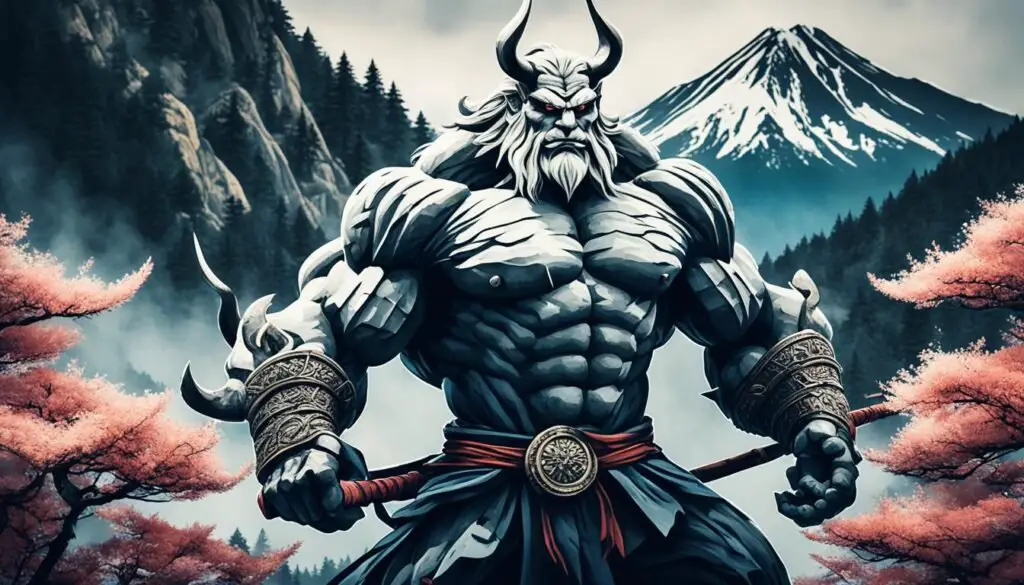
Japanese folklore is filled with fascinating legends of legendary giants. These mythical creatures have captured the imaginations of the Japanese people for centuries.
Two prominent examples of these legendary giants are the Ōmukade and the Daidarabotchi.
Ōmukade – The Giant Centipede: Ōmukade is a legendary giant centipede known for its fearsome size and deadly venom.
In Japanese folklore, it is depicted as a monstrous creature that terrorizes the land. The legend of Ōmukade represents the power and danger of nature, showcasing the unique aspects of Japanese giant mythology.
Daidarabotchi – The Mountain-Shaping Giant: Daidarabotchi is another legendary giant in Japanese folklore, responsible for shaping mountains and creating landscapes.
This giant is often depicted as a colossal figure that traverses the land, rearranging the natural terrain with ease.
The tale of Daidarabotchi highlights the profound connection between giants and the shaping of the natural world.
To dive deeper into the awe-inspiring stories of these legendary giants, take a look at the captivating image below:
Exploring the tales of Ōmukade and Daidarabotchi allows us to truly appreciate the mythical creatures that hold a significant place in Japanese folklore and have become enduring symbols of power and wonder in Japanese culture.
What are the Symbolic Meanings of Giants in Japanese Mythology?
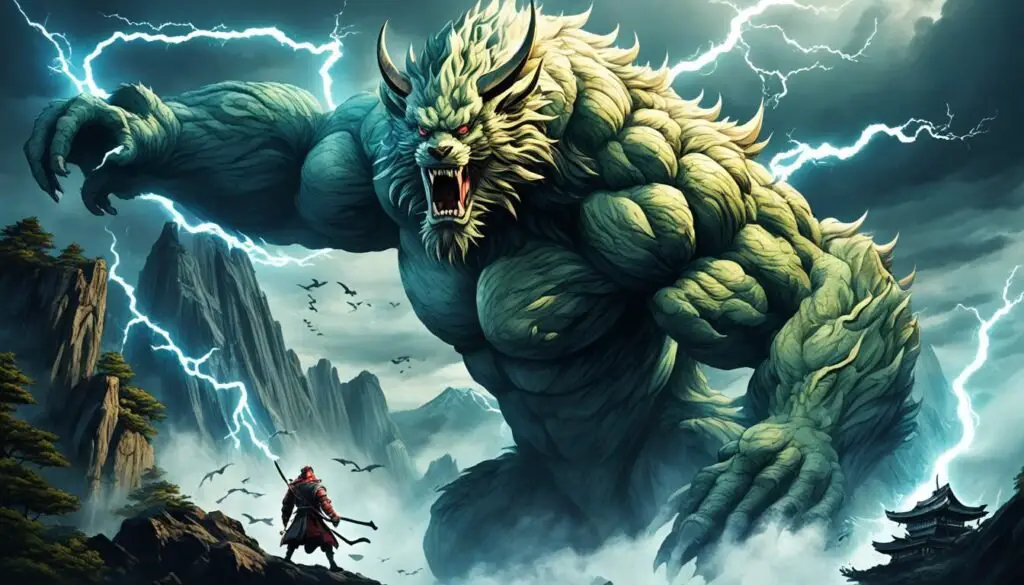
Giants as Symbols of Natural Forces
In Japanese mythology, giants hold significant symbolic meanings that extend beyond their physical attributes.
They are often associated with natural forces, representing the power and unpredictability of nature.
Just as nature can be both awe-inspiring and terrifying, giants embody these dualities, showcasing the immense strength and potential danger inherent in the natural world.
Their towering stature and formidable presence serve as reminders of the grandeur and forces at work in the world.
Giants and Cultural Morals
Giants in Japanese mythology also carry cultural morals and messages. They serve as cautionary figures, embodying the consequences of human actions and the importance of respecting the natural order.
These moral lessons are often intertwined with stories of giants, teaching individuals about the harmony between humans and nature, and the necessity of living in balance with the world around them.
Giants showcase the interconnectedness of all beings and the need to treat nature with reverence and care.
What is the Role of Giants in Shinto and Buddhism?
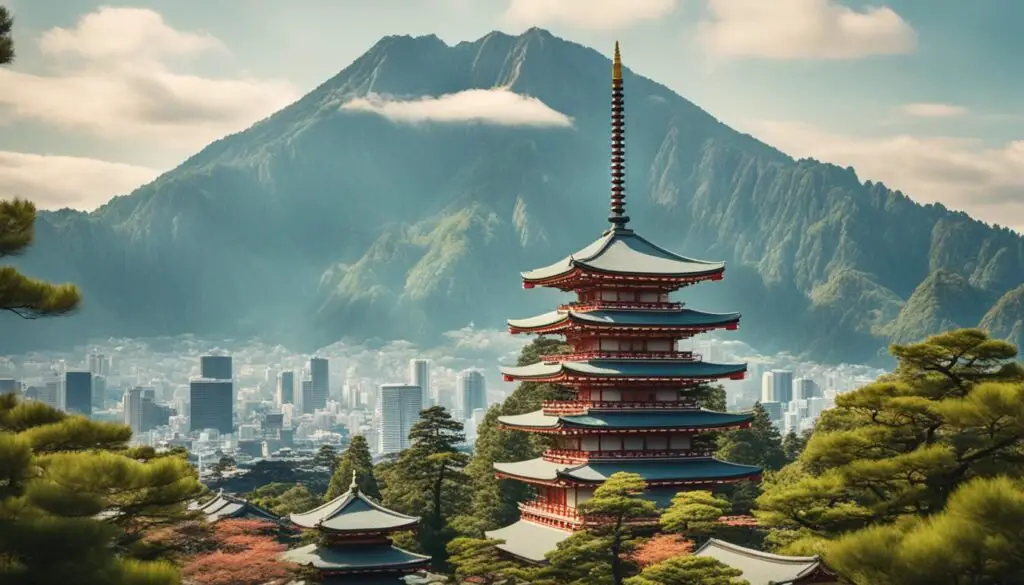
Giants hold significant roles in Shinto and Buddhism, two major religions in Japan. In the realm of Shinto mythology, giants are revered as deities that embody natural elements and forces.
They are held in high regard and believed to have the power to influence the natural world.
Their presence and influence in Japanese society are deeply ingrained in the spiritual and cultural fabric of the country.
Buddhism, on the other hand, introduces another layer of significance to the role of giants in Japanese mythology.
The influence of Buddhist teachings on giant legends adds elements of karma, rebirth, and the pursuit of enlightenment.
This integration of Buddhist beliefs enhances the spiritual significance of giants and contributes to a deeper understanding of their cultural symbolism.
Exploring the role of giants in both Shinto and Buddhism allows us to gain insights into their spiritual and cultural significance in Japanese society.
It highlights the complex interplay between religion, mythology, and cultural beliefs, showcasing the enduring impact of giants in shaping the Japanese worldview.
Giants in Shinto Mythology
In Shinto mythology, giants are revered as divine beings associated with the natural world.
They are often perceived as deities who embody the power and essence of various natural elements and forces.
From towering mountains to raging storms, giants hold sway over the natural landscape, commanding respect and awe from those who acknowledge their presence.
These divine giants play a vital role in the indigenous religion of Shinto, reflecting the Japanese people’s reverence for the natural world.
They are seen as guardians and protectors, maintaining harmony between humanity and the environment.
Shinto followers believe that by respecting and worshipping these giants, they can ensure a harmonious coexistence with nature and receive blessings and protection.
Buddhist Influence on Giant Legends
Buddhist teachings have left a lasting imprint on the legends surrounding giants in Japanese mythology.
Buddhism introduced concepts such as karma, rebirth, and the pursuit of enlightenment, which intertwine with the narrative of giants.
These Buddhist influences contribute to the spiritual context and deeper meaning associated with giants in Japanese folklore.
The incorporation of Buddhist beliefs expands the role of giants beyond their association with natural elements.
Giants become symbolic figures, representing the consequences of human actions and the cyclical nature of existence.
They embody the Buddhist teachings of cause and effect, reminding individuals of the interconnectedness of all beings and the importance of leading virtuous lives.
Furthermore, the pursuit of enlightenment and liberation from suffering, central to Buddhist philosophy, adds a spiritual dimension to the role of giants in Japanese mythology.
Giants represent the journey toward self-realization and ultimate transcendence, inspiring individuals to seek enlightenment and break free from the cycle of rebirth.
By understanding the role of giants in both Shinto and Buddhism, we gain valuable insights into the spiritual and cultural significance of these mythical beings in Japanese society.
Their presence reflects the deep-rooted connection between religion, mythology, and the collective consciousness of the Japanese people.
What are the Giants in Japanese Art and Literature?
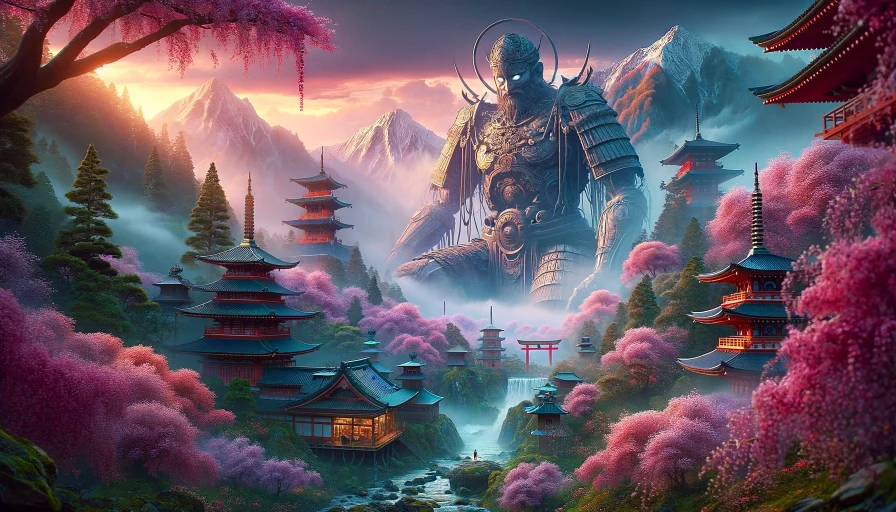
Giants have long been a source of inspiration for Japanese artists and writers. Traditional art forms like woodblock prints and paintings often depict giants in awe-inspiring and fearsome forms.
These depictions showcase the cultural significance and symbolism associated with giants.
In modern Japanese media, giants continue to captivate audiences in various forms, including anime, movies, and video games.
The influence of giants in Japanese literature is evident through powerful and imaginative narratives that explore the themes of heroism, adventure, and the clash between humans and mythical creatures.
The portrayal of giants in both traditional art and modern Japanese media reflects their enduring popularity and the creative interpretations that keep them alive in the imagination of the audience.
Comparing Japanese Giants to Other Cultures
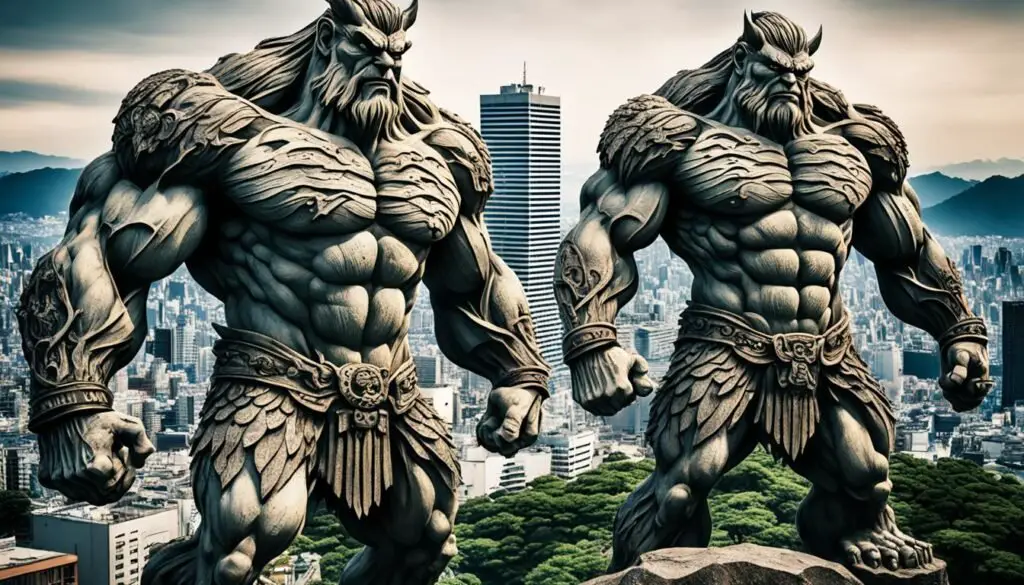
Exploring the world of Japanese giants and their counterparts in other mythologies allows us to uncover fascinating similarities and appreciate the unique aspects that make Japanese giants distinct.
As we delve into the comparison between Japanese giants and giants from other cultures, we gain deeper insights into the universal themes, cultural influences, and interconnectedness of mythologies worldwide.
Similarities with Other Mythologies:
- In many mythologies, giants are often depicted as powerful beings with immense strength and size, instilling awe and fear in those who encounter them. This portrayal resonates across cultures and signifies the universal fascination with larger-than-life creatures.
. - Like Japanese giants, giants in other mythologies often embody natural forces and represent the power and unpredictability of nature. They are associated with mountains, storms, and other elements, reflecting the deep connection between humans and the natural world.
. - Giants in various mythologies often symbolize the clash between order and chaos, reflecting the eternal struggle between opposing forces in the universe and serving as a reminder of the delicate balance that must be maintained.
Unique Aspects of Japanese Giants:
- Japanese giants are deeply rooted in the specific beliefs, values, and historical context of Japan. They embody the cultural and spiritual significance attributed to nature, reflecting the reverence for the natural world in Japanese society.
. - Unlike giants in some other mythologies, Japanese giants often carry moral lessons and serve as cautionary figures. Their stories highlight the consequences of human actions and the importance of respecting the natural order, conveying valuable cultural morals.
. - Japanese giants are intricately woven into the fabric of Japanese art, literature, and religious beliefs, showcasing their enduring presence and influence in Japanese culture throughout history.
The image above captures the imagination and visual representation of Japanese giants, showcasing their powerful and awe-inspiring presence.
The image serves as a reminder of the cultural impact and significance of these mythical creatures in Japanese society.
By comparing Japanese giants to giants in other mythologies, we gain a deeper appreciation for the universal themes, cultural influences, and unique aspects that shape these captivating creatures across different cultures.
Exploring these connections broadens our understanding of mythology as a whole and highlights the rich tapestry of beliefs and stories that continue to intrigue and inspire us.
Conclusion
The giants of Japanese mythology hold a special place in the hearts and imaginations of the Japanese people.
These mythical creatures embody cultural values, symbolize natural forces, and carry moral lessons.
Giants play significant roles in Japanese art, literature, and religious beliefs.
By exploring the legends and symbolism of giants in Japanese mythology, we gain a deeper understanding of Japanese culture and its enduring legacy.
The tales of these giants allow us to connect with the captivating narratives that have fascinated generations and continue to inspire awe and wonder.
It is through the appreciation of the rich tapestry of Japanese giant legends that we can truly comprehend the depth and complexity of Japanese mythology.
From their representation in traditional art forms to their presence in modern Japanese media, giants have remained a source of inspiration and fascination.
The enduring popularity of these mythical creatures speaks to their timeless appeal and the resonance they hold in the collective consciousness of the Japanese people.
We can appreciate the intricate details, creative interpretations, and cultural significance associated with giants in Japanese mythology.
Frequently Asked Questions
Q: What is a giant in Japanese folklore?
A: In Japanese folklore, giants (known as “kaiju” in modern contexts) refer to large, mythical creatures or beings that often possess supernatural powers. Traditional folklore does not specifically use a term equivalent to “giant” as in Western myths, but many creatures display giant-like qualities.
Q: What is the giant skeleton in Japanese mythology?
A: The giant skeleton, known as “Gashadokuro,” is a mythical creature in Japanese folklore. It’s depicted as a massive, skeletal monster that roams at night, making a sound like rattling bones, and preys on humans by biting off their heads.
Q: What is the giant spider in Japanese mythology?
A: The giant spider in Japanese mythology is often referred to as “Tsuchigumo” or “Jorōgumo.” These are mythical spiders that can change their appearance, often into that of a seductive woman, to lure and prey on humans.
Q: What is a giant monster in Japanese?
A: A giant monster in Japanese is commonly referred to as “Kaiju.” These creatures often appear in modern media, particularly in movies and television shows, where they are depicted as colossal monsters that cause destruction and chaos.
Q: What is the giant centipede in Japanese mythology?
A: The giant centipede in Japanese mythology is known as “Ōmukade.” It is a monstrous centipede that dwells in mountains, feared for its venom and size, often battling with legendary heroes and deities.
Q: What are the most terrifying monsters in Japanese mythology?
A: Among the most terrifying monsters in Japanese mythology are “Oni” (demons), “Yuki-onna” (the snow woman), “Kuchisake-onna” (the slit-mouthed woman), and “Gashadokuro” (the giant skeleton), all of which have chilling tales and are known for their malevolence towards humans.
Q: What is the fearsome creature of Japanese folklore?
A: One of the fearsome creatures of Japanese folklore is the “Nue,” described as a chimera with the face of a monkey, the legs of a tiger, the body of a Tanuki, and the front half of a snake as a tail. It is known to bring misfortune and illness.


